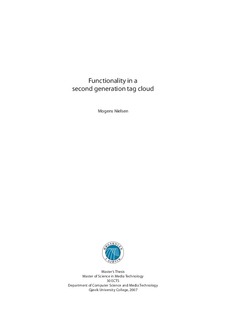Functionality in a second generation tag cloud
Master thesis
Permanent lenke
http://hdl.handle.net/11250/144072Utgivelsesdato
2007Metadata
Vis full innførselSamlinger
- Institutt for design [1096]
Sammendrag
NORSK:
Tagging er en form for metadata som har blitt mer og mer populær. Flere og flere nettsider
bruker tagging for å beskrive ressursene som finnes i deres system. Disse ressursene
kan være bilder på Flickr, eller andre nettsider som på del.icio.us. Behovet for
å visualisere informasjonen i et tagging-system har økt sammen med populariteten av
disse systemene.
Tagskyen er en populær måte å visualisere denne informasjonen. I denne thesis har
vi funnet begrensninger ved en første generasjons tagsky. Ved å undersøke brukerne
av en tagsky og måten de bruker den til å finne informasjon, har vi undersøkt disse
begrensningene. Og ved å studere relatert arbeid, har vi funnet måter vi kan unngå disse
begrensningene. Noen av disse løsningen har blitt implementert i et proof of concept for
å vise hvordan vi ser for oss en andre generasjon tagsky.
For å evaluere løsningene og deres innflytelse på taggesystemet og tagskyens interface,
har vi undersøkt deres bidrag i forhold til et sett med definerte brukerroller.
Resultatene våre viser hvordan en andre generasjons tagsky kan se ut og hvordan nye
funksjonaliteter kan forbedre den som et information visualization interface. ENGELSK:
With the growing popularity of collaborative tagging systems—like Flickr, del.icio.us,
Technorati and many more—the use of tags has become evermore popular. The need
for a way to visualise the information within a collaborative tagging system has likewise
become increasingly necessary.
The tag cloud is a popular way of visualizing the information in a collaborative tagging
system. In this thesis, we have pointed to limitations of the first generation tag cloud as
an information visualization interface. By examining the users of a tag cloud and the
way they employ it to retrieve information, we have examined these limitations. And by
studying related research, we have found ways to avoid these limitations. Some of these
solutions has been implemented in a proof of concept to visualize a concept of a second
generation tag cloud.
To evaluate the solutions and their impact on the tagging system and tag cloudinterface,
we have examined their contributions in relation with a set of defined userroles.
Our results show how a second generation tag cloud may look and how new functionality
can improve it as an information visualization interface.
